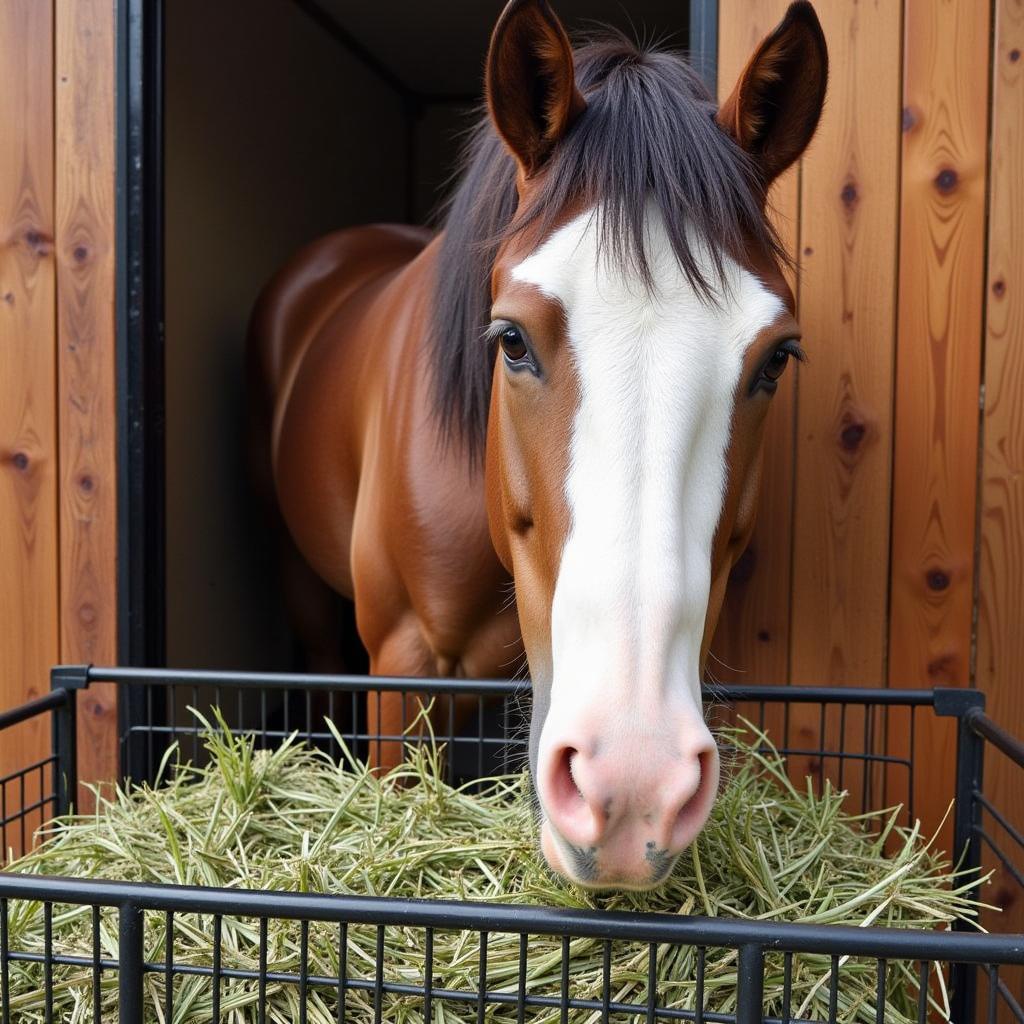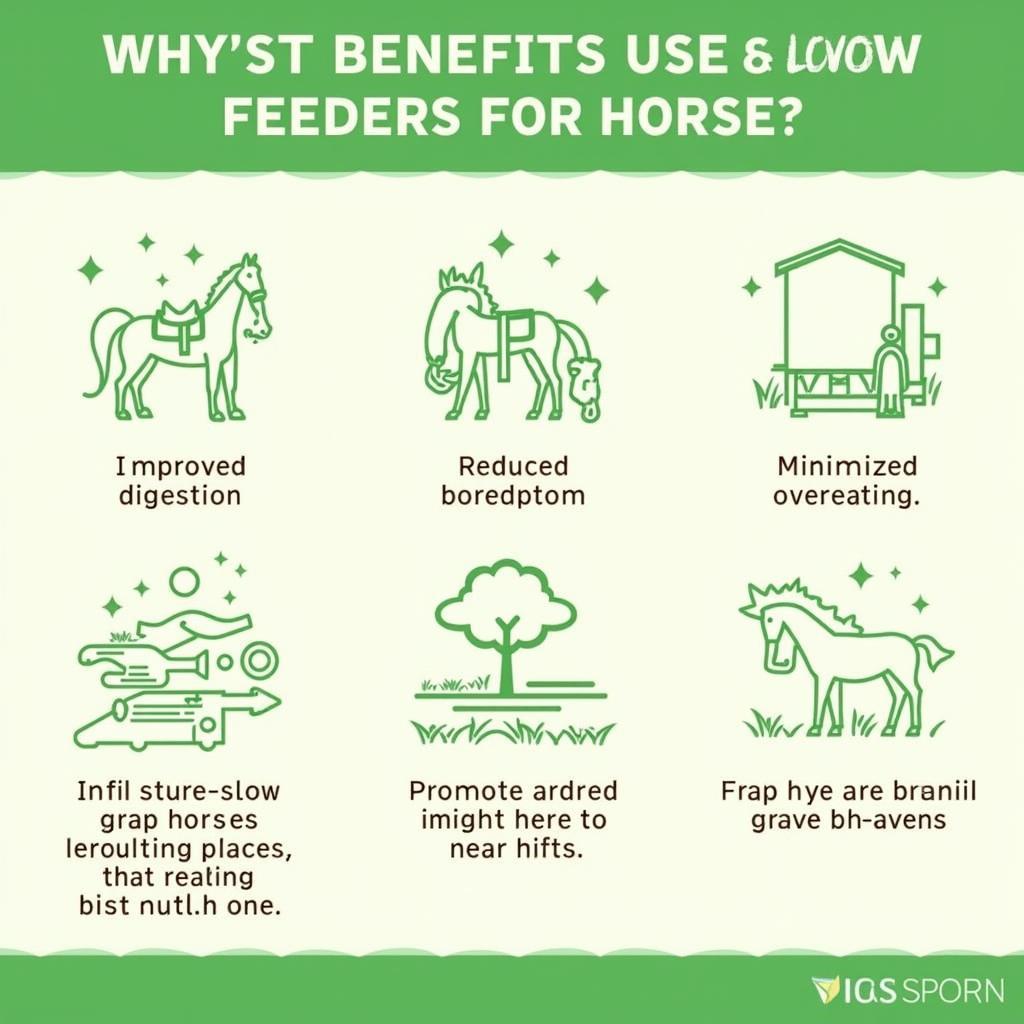Horse Slow Feeders have become increasingly popular among horse owners in recent years. But what exactly are they, and why are they so beneficial for your equine companion? This comprehensive guide will delve into the world of horse slow feeders, covering everything from their purpose and benefits to different types available and factors to consider when choosing the perfect one for your horse.
 Horse Eating From a Slow Feeder
Horse Eating From a Slow Feeder
Why Use a Horse Slow Feeder?
Horses are natural grazers, designed to nibble on forage throughout the day. In their natural environment, they would roam vast distances, consuming small amounts of low-calorie grasses and plants over extended periods. However, domestication often limits their access to constant grazing. This is where horse slow feeders come into play. They mimic natural grazing habits by:
- Reducing eating speed: Slow feeders use various mechanisms to limit the rate at which a horse can consume its food. This helps prevent overeating and its associated health risks.
- Prolonging feeding time: By extending the amount of time it takes for a horse to finish its meal, slow feeders help alleviate boredom and reduce stress.
- Promoting digestive health: Eating slowly and steadily encourages proper digestion and nutrient absorption, minimizing the risk of digestive upset and colic.
 Benefits of Horse Slow Feeders
Benefits of Horse Slow Feeders
Different Types of Horse Slow Feeders
There is a wide variety of horse slow feeders available on the market, each with its own pros and cons. Here are some popular types:
Hay Nets
horse nets are a cost-effective and widely used option. They come in various sizes and mesh densities, allowing you to control the flow of hay. However, ensure the mesh size is appropriate to prevent tooth damage or frustration.
Grid Feeders
These feeders feature metal or plastic grids that horses must eat through to access the hay. They are durable and easy to clean but require careful selection to match the horse’s size and eating habits.
Slow Feed Buckets and Bags
Ideal for feeding grain or concentrated feed, these containers have small openings or obstacles that force horses to eat slowly. This is particularly useful for horses prone to bolting their feed.
Ground Feeders
These feeders sit directly on the ground, encouraging a more natural grazing position. They are often made from durable rubber and are suitable for both hay and grain.
Choosing the Right Slow Feeder for Your Horse
Selecting the appropriate slow feeder depends on various factors, including your horse’s:
- Size and Breed: Larger breeds require larger feeders, while smaller horses might benefit from designs with smaller openings.
- Eating Habits: Consider your horse’s eating speed and any specific needs, such as a tendency to bolt food.
- Living Environment: Choose a feeder suitable for your horse’s stall, paddock, or pasture.
“It’s crucial to assess your horse’s individual needs and preferences when choosing a slow feeder,” advises Dr. Emily Carter, Equine Nutritionist. “Factors such as their size, eating habits, and any existing health conditions should guide your decision.”
Conclusion: Embracing Slow Feeding for a Healthier Horse
Implementing slow feeding practices using horse slow feeders can significantly benefit your equine companion’s well-being. By promoting natural grazing habits, reducing eating speed, and encouraging proper digestion, you can help ensure your horse enjoys a long, healthy, and happy life.
Don’t hesitate to consult with your veterinarian or an equine nutritionist to determine the best slow feeding approach and choose the most suitable horse slow feeder for your beloved companion.
FAQ about Horse Slow Feeders
1. Can I leave my horse unattended with a slow feeder?
Yes, slow feeders are designed for unsupervised use and can be safely left with your horse throughout the day or night. However, always monitor your horse’s behavior and feeder’s condition to ensure safety and functionality.
2. How much hay should I put in a slow feeder?
The amount of hay to put in a slow feeder depends on your horse’s size, activity level, and the feeder’s capacity. It’s best to consult with your veterinarian for personalized recommendations.
3. Can I use a slow feeder for grain or concentrated feed?
While some slow feeders are specifically designed for grain and concentrated feed, others are more suitable for hay. Choose a feeder appropriate for the type of feed you intend to provide.
4. How often should I clean my horse’s slow feeder?
Regular cleaning is essential to prevent mold and bacteria growth. Clean the feeder thoroughly with soap and water at least once a week, or more frequently depending on usage and environmental conditions.
5. Where can I find high-quality horse slow feeders?
You can find a wide selection of horse slow feeders at reputable tack shops, online retailers, and through agricultural supply stores.
For more information on other horse feeding options, consider exploring these articles:
If you need further assistance in choosing the right slow feeding solutions for your horse, our team at Justus Horses USA is always here to help. Contact us at 0772127271 or [email protected]. You can also visit us at our location QGM2+WX2, Vị Trung, Vị Thuỷ, Hậu Giang, Việt Nam, for personalized advice and a wide selection of horse care products. Our dedicated customer support team is available 24/7 to answer your questions and address your concerns.